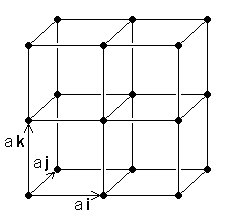5 The Reciprocal Lattice
Although the Bragg law gives a simple and convenient method for calculating the separation of crystallographic planes, further analysis is necessary to calculate the intensity of scattering from a spatial distribution of electrons within each cell.
Fourier analysis of the periodic nature of crystal lattices reveals the importance of a set of vectors, G, related to the lattice vectors a, b and c. The set of vectors G is labelled the ‘reciprocal lattice’. Each crystal lattice has an associated reciprocal lattice which makes calculation of the intensities and positions of peaks much easier. The reciprocal lattice vectors are constructed as follows:
![]()
If
a, b and c are primitive
lattice vectors of the crystal lattice then a*, b* and c*
are primitive lattice vectors of the reciprocal lattice.
Any set of primitive lattice points gives rise to the same set of
reciprocal lattice points. The
reciprocal lattice vectors have the properties:
5 The Reciprocal Lattice


